Related Research Articles

Transport in India consists of transport by land, water and air. Road transport is the primary mode of transport for most Indian citizens, and India's road transport systems are among the most heavily used in the world.
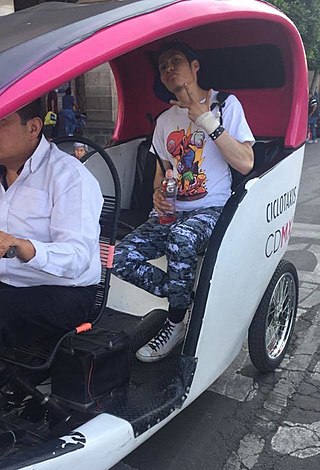
The cycle rickshaw is a small-scale local means of transport. It is a type of hatchback tricycle designed to carry passengers on a for-hire basis. It is also known by a variety of other names such as bike taxi, velotaxi, pedicab, bikecab, cyclo, beca, becak, trisikad, sikad, tricycle taxi, trishaw, or hatchback bike.
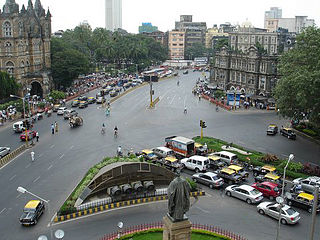
Transport in Mumbai is achieved by both public and private transport. As of 2016, 52% of commuters use public transport. Mumbai has the largest organized bus transport network among major Indian cities.
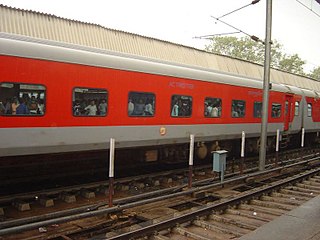
The Rajdhani Express is a series of passenger train services in India operated by Indian Railways connecting the national capital New Delhi with the capitals or the largest cities of various states. Rajdhani, derived from the Sanskrit means "capital". Introduced in 1969, the trains are amongst the premium services operated by Indian Railways and regularly get a higher priority on the railway network.

An auto rickshaw is a motorized version of the pulled rickshaw or cycle rickshaw. Most have three wheels and do not tilt. They are known by many terms in various countries including auto, auto rickshaw, baby taxi, mototaxi, pigeon, jonnybee, bajaj, chand gari, lapa, tuk-tuk, tum-tum, Keke-napep, Maruwa, Adaidaita Sahu, 3wheel, pragya, bao-bao, easy bike, and tukxi.

Women-only passenger cars are railway or subway cars intended for women only. They are a result of sexual segregation in some societies, but also can result from attempts to reduce sexual harassment and assault such as groping.
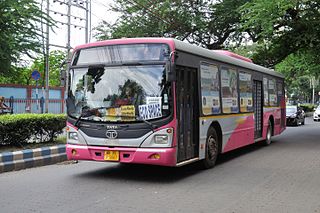
The transport system of Kolkata, a city in India, is a mix of modern mass rapid transport and old transport modalities like rickshaws. Kolkata is connected to the rest of India by the National Highways, the extensive network of the Indian Railways, National Waterways and by air. The most traffic to Northeast India route is via Kolkata.

Delhi has significant reliance on its transport infrastructure. The city has developed a highly efficient public transport system with the introduction of the Delhi Metro, which is undergoing a rapid modernization and expansion since 2006. There are 16.6 million registered vehicles in the city as of 30 June 2014, which is the highest in the world among all cities, most of which do not follow any pollution emission norm, while the Delhi metropolitan region has 11.2 million vehicles. Delhi and NCR lose nearly 42 crore man-hours every month while commuting between home and office through public transport, due to the traffic congestion. Therefore, serious efforts, including a number of transport infrastructure projects, are under way to encourage usage of public transport in the city.

Tuctuc Ltd was an auto rickshaw operator in Brighton, England. It operated for just over a year from the summer of 2006 until late 2007, but opposition from taxi operators and licence breaches "made the service unworkable" and the vehicles were withdrawn. In 2009, they were used again for weekend sightseeing tours of the city.

Cars such as Toyota Etios, Maruti Omni, Mahindra Logan, Maruti Suzuki, Tata Indica and Tata Indigo are fairly popular among taxicab operators. The livery of the taxicabs in India varies from state to state. In Delhi and Maharashtra, most taxicabs have yellow-black livery, while in West Bengal, taxis have yellow livery. Private taxicab operators are not required to have a specific livery. However, they are required by law to be registered as commercial vehicles.

Rickshaw originally denoted a pulled rickshaw, which is a two- or three-wheeled cart generally pulled by one person carrying one passenger. The first known use of the term was in 1879. Over time, cycle rickshaws, auto rickshaws, and electric rickshaws were invented, and have replaced the original pulled rickshaws, with a few exceptions for their use in tourism.
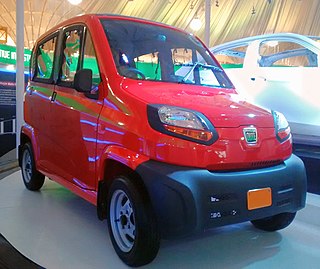
The Bajaj Qute, earlier called Bajaj RE60, is a rear-engine, rear-wheel-drive, four-passenger quadricycle built by the Indian company Bajaj Auto and is aimed primarily at the Indian domestic market. The car was the first four-wheeler manufactured by Bajaj Auto, which was unveiled on 3 January 2012. In India, the Qute is not legally classified as a car.
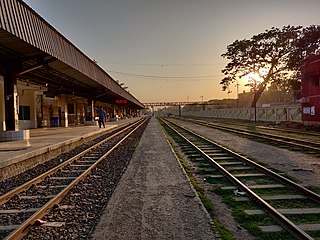
Soro is a city and a municipality in Balasore district in the Indian state of Odisha. It is about 181 km from the capital of the state Bhubaneswar and 35 km from the district headquarters Balasore. Located on NH-16, the city is located midway between Balasore and Bhadrak cities. Soro along with neighboring cities contributes significantly towards the economy of Balasore district.It has many important areas like Uttareswar, Adang Bazar, College chaka,Badkhuri chaka,Court chaka etc.

The Kalinga Stadium is a multi-purpose international sports complex in Bhubaneswar, Odisha, India. Its foundation stone was laid by the former chief minister of Odisha Biju Patnaik in 1978. It is best known as the home ground of the Indian Super League club Odisha FC since its inception in 2019. It was the home ground of the I-League club Indian Arrows from 2018 until 2022. It is situated in the heart of Bhubaneswar near Nayapalli area. It has facilities for athletics, football, field hockey, tennis, table tennis, basketball, volleyball, wall climbing and swimming. Other features of the stadium includes an 8-lane synthetic athletics track, high performance centres, and India's first Olympic standard pink and blue water-based AstroTurf.

The Indian metropolis of Bhubaneswar has approximately 1,600 kilometres (990 mi) of roads, with average road density of 11.82 square kilometres (4.56 sq mi). Baramunda Inter State Bus Terminus (ISBT) is the major bus terminus in the city from where buses ply to all the districts in Odisha as well as to neighbouring state's cities like Hyderabad, Kolkata, Visakhapatnam, Raipur and Ranchi. City bus service runs in public-private partnership between Bhubaneswar-Puri Transport Service Limited (BPTSL) and Dream Team Sahara (DTS) under JNNURM scheme. A fleet of 185 buses cover all major destinations including Cuttack, Puri and Khordha. Auto rickshaws are available for hire and on a share basis throughout the city. In parts of the city, cycle rickshaws offer short trips. To ease traffic jams, over-bridges at major road junctions and expansion of roads are under construction. In a study of six cities in India, Bhubaneswar was ranked third concerning pedestrian infrastructure. The city scored 50 points out of maximum 100. The government of Odisha introduced the much-awaited Bhubaneswar BRTS in Bhubaneswar.
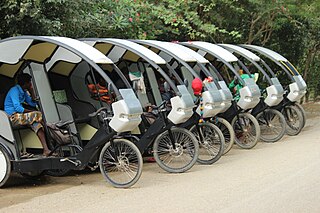
Electric rickshaws are small 3-wheeled vehicles powered by a battery-powered electric motor ranging from 650 to 1,400 watts. These small electric vehicles have lower fuel costs than auto rickshaws and greater mobility than pulled rickshaws leading to their popularity and widening acceptance in some cities since 2008. Electric rickshaws are mostly manufactured in India, Bangladesh, Nepal, and China.

Ola Cabs is an Indian transportation company that provides ridesharing services and operates other business verticals such as financial services and cloud kitchens. It is headquartered in Bangalore, Karnataka and operates in 250+ Indian cities.

There are various modes of transportation available in Eluru, a city in the Indian state of Andhra Pradesh, and its region. It includes auto rickshaws, bicycles to mass transit systems – such as buses and trains. The city was once famed for its traffic problems with the railway gates at Vatluru, Venkatraopet, Powerpet, Old bus stand and Eastern Locks areas. When the National Highway passed through the city, the traffic hurried to pass over the railway gates in the city and outskirts, which makes traffic worse.
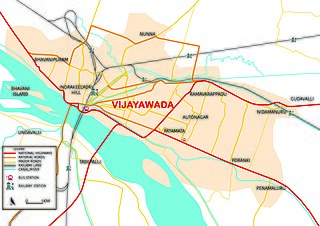
Transport in Vijayawada is the network of roads, railways, rapid transit system in the second largest city of Andhra Pradesh. The city of Vijayawada also serves as the central hub of transport and logistics within the state.
Transport in Bangalore consists of several intracity commute modes such as BMTC buses, Namma Metro rail services, taxis and auto rickshaws, as well as several intercity forms of transport: Government operated KSRTC, NWKRTC, KKRTC, other states RTC buses, Private bus operators, trains, and flights.
References
- 1 2 "What happened to the pink auto? - Times of India". The Times of India. 2 March 2013. Retrieved 2019-03-12.
- 1 2 "'Pink autos' launched in Gurgaon". News18. 12 January 2013. Retrieved 2019-03-12.
- 1 2 "Pink autos in Ranchi no longer 'women only' - Times of India". TimesofIndia.IndiaTimes.com . 11 September 2018. Retrieved 2019-03-12.
- ↑ "Pink Autos: Women Driven Auto Rickshaw Services In India". Naaree - Work From Home Career Advice, Indian Women's Magazine. 2016-12-13. Retrieved 2019-03-12.
- 1 2 "Pink Auto Rickshaw Project" (PDF). Odisha Police Department. Odisha Police. 27 June 2015.
- 1 2 "City to get pink autos with women on wheels". www.millenniumpost.in. 5 February 2018. Retrieved 2019-07-09.
- ↑ "Driven out: Ranchi's auto service by and for women is dying". HindustanTimes.com . 2015-04-09. Retrieved 2019-03-12.
- ↑ "Launch of Pink Auto Rickshaws programme in Surat". DeshGujarat. 2017-07-02. Retrieved 2019-03-12.
- ↑ "New auto service in Surat: By the women, for the women - Times of India". TimesofIndia.IndiaTimes.com . 3 July 2017. Retrieved 2019-03-12.
- ↑ "Pink Auto Service arrives in Surat". www.cityshor.com. Retrieved 2019-03-12.
- ↑ "In Surat now: A pink auto service by women, for women". IndianExpress.com . 2017-07-03. Retrieved 2019-03-12.
- ↑ "Assam: 13 pink auto-rickshaws for women launched in Bongaigaon". TheNortheastToday.com. Archived from the original on 2019-03-06. Retrieved 2019-03-12.
- ↑ "In Bongaigaon, pink is the colour of safety". TelegraphIndia.com . Retrieved 2019-04-22.
- ↑ Pioneer, The. "Pink auto service launched in R'kela". DailyPioneer.com . Retrieved 2019-03-12.
- ↑ "Pink autos for women fading out of roads - Times of India". The Times of India. 15 March 2018. Retrieved 2019-03-12.
- ↑ "Gurgaon's pink autos for women a failure despite rising cases of sexual assault". News18. 12 December 2014. Retrieved 2019-03-12.